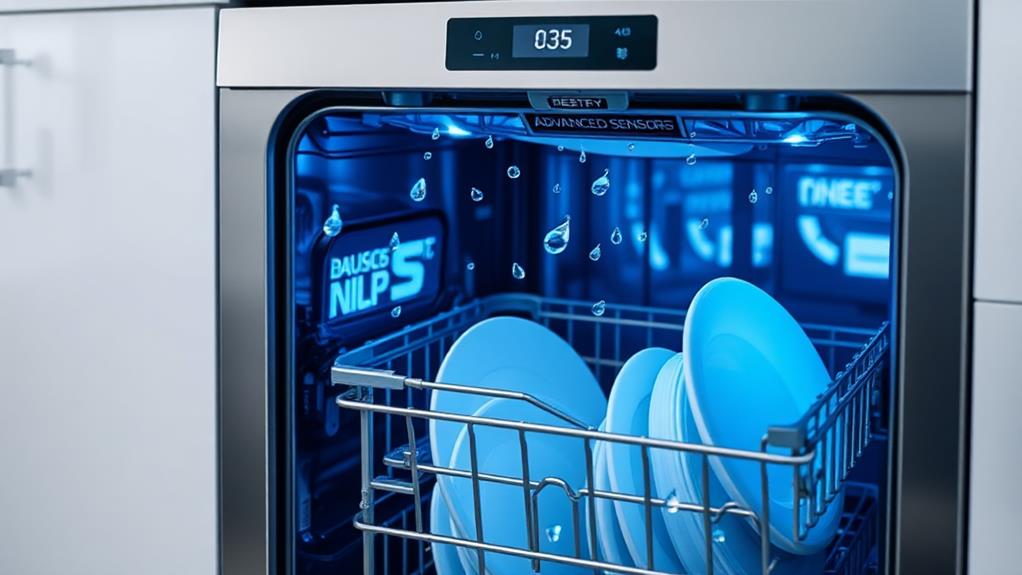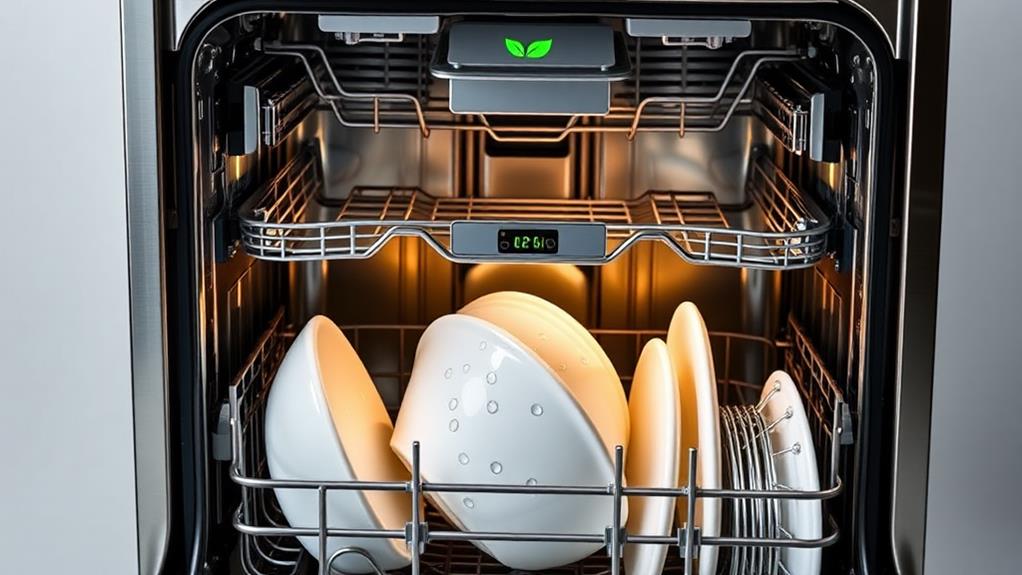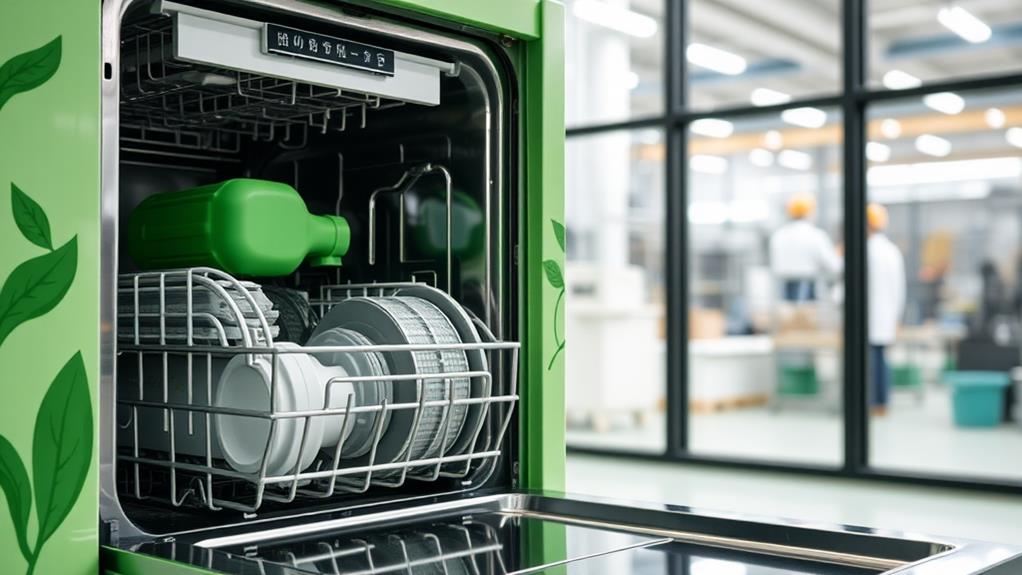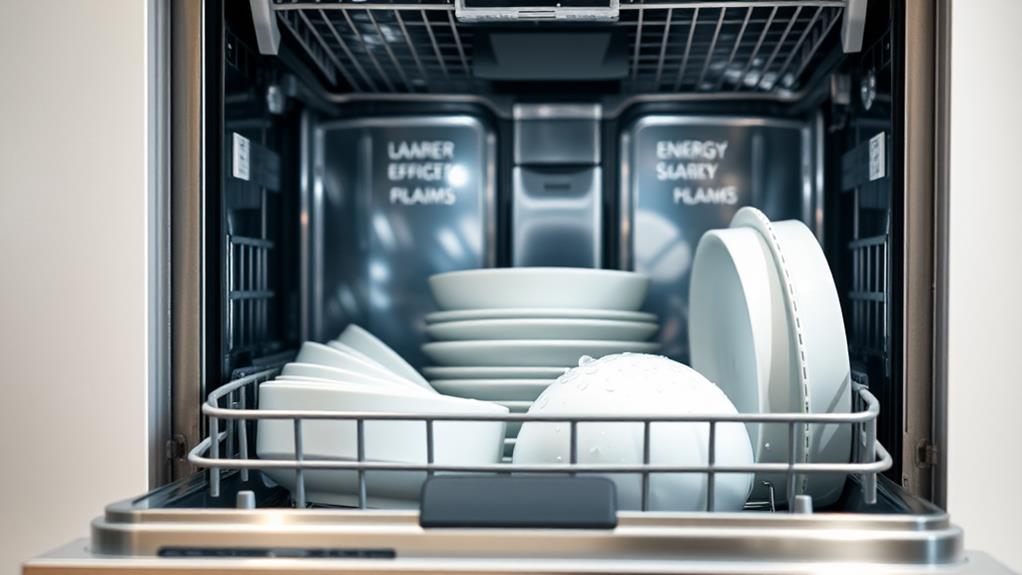Modern dishwashers employ cutting-edge technologies to save water and energy without compromising cleaning performance. You'll find advanced sensors that detect soil levels, load size, and temperature, optimizing each cycle for efficiency. Water-efficient features like eco-cycles, precision spray arms, and targeted jets clean effectively while using less water. Energy-saving designs include improved insulation, heat exchange systems, and air-dry options. Smart connectivity allows remote control and monitoring via smartphone apps, helping you maximize efficiency. Many models also use eco-friendly materials and manufacturing processes. These innovations not only reduce your utility bills but also minimize your environmental impact. Discover how these technologies can transform your dishwashing experience.
Advanced Sensor Technologies

Three key sensor technologies have revolutionized dishwasher efficiency. First, soil sensors detect the level of dirt on your dishes, adjusting the wash cycle accordingly. You'll save water and energy when your dishes are only lightly soiled, as the machine won't unnecessarily run a heavy-duty cycle.
Next, temperature sensors ensure optimal water temperature throughout the wash. They'll activate the heating element only when needed, reducing energy consumption while maintaining cleaning effectiveness. You'll notice improved performance and lower utility bills as a result.
Finally, load sensors determine the size and distribution of your dishes. They'll adjust water usage based on how full your dishwasher is, preventing waste when you're running a partial load. You'll conserve resources without sacrificing cleanliness.
These advanced sensors work together to create a more intelligent washing process. They'll continuously monitor and adapt to your specific needs, optimizing each cycle for maximum efficiency. By investing in a dishwasher with these technologies, you're not only saving money but also reducing your environmental impact. Your dishes will come out spotless while using less water and energy than ever before.
Water-Efficient Cleaning Cycles
Modern dishwashers boast a variety of water-efficient cleaning cycles designed to maximize cleaning power while minimizing water usage. You'll find options like eco-cycles that use less water and energy for lightly soiled dishes, and quick-wash cycles that clean dishes in as little as 30 minutes. These cycles often employ precision spray arms and targeted water jets to clean effectively with less water.
Many dishwashers now feature half-load or upper-rack-only cycles, allowing you to wash smaller loads without wasting water on empty spaces. Some models use innovative technologies like steam cleaning or pre-soak cycles to loosen tough food particles before the main wash, reducing the need for water-intensive pre-rinsing.
Advanced models may incorporate water recycling systems, capturing and filtering water from the final rinse to use in the pre-rinse of the next cycle. You'll also find dishwashers with adjustable water pressure settings, allowing you to customize the cycle based on the soil level of your dishes. These water-efficient cycles not only save resources but can also lead to significant reductions in your water and energy bills over time.
Energy-Saving Design Features

Innovative design features in today's dishwashers are revolutionizing energy efficiency. You'll find that modern units incorporate insulation to retain heat, reducing the energy needed to maintain water temperature. Many models now use sensor-based technology to adjust water usage and cycle duration based on the load size and soil level, optimizing energy consumption.
Heat exchange systems are another energy-saving feature you'll encounter. These systems capture heat from the final rinse cycle and use it to preheat water for the next wash, reducing the energy required to heat water from scratch. Some dishwashers also employ air-dry or fan-dry options instead of heat-dry cycles, significantly cutting down on electricity use.
You'll notice that many dishwashers now come with multiple wash zones, allowing you to run smaller loads in specific areas of the machine. This feature saves both water and energy when you don't have a full load. Additionally, eco-friendly programs and half-load options further contribute to energy conservation. LED lighting and efficient motors are also becoming standard, enhancing overall energy performance without compromising cleaning effectiveness.
Smart Connectivity Options
Smart connectivity has revolutionized the way you interact with your dishwasher. Modern dishwashers now come equipped with Wi-Fi capabilities, allowing you to control and monitor your appliance remotely through smartphone apps. You can start or stop cycles, check remaining time, and receive notifications when your dishes are clean, all from the palm of your hand.
These smart features also enable your dishwasher to download new wash cycles and updates, ensuring optimal performance and energy efficiency. Some models can even integrate with smart home systems, responding to voice commands through virtual assistants like Alexa or Google Home.
Energy management is another benefit of smart connectivity. Your dishwasher can communicate with your utility provider to run during off-peak hours, saving you money on electricity bills. Additionally, it can detect and alert you to potential issues, such as leaks or maintenance needs, preventing costly repairs and water waste.
Smart dishwashers can also learn your usage patterns and suggest the most efficient cycles based on your habits. This personalization helps optimize water and energy consumption, making your appliance even more eco-friendly and cost-effective in the long run.
Eco-Friendly Materials and Manufacturing

Manufacturers are increasingly embracing eco-friendly materials and production methods in dishwasher design and construction. You'll find that many modern dishwashers now incorporate recycled plastics and metals in their components, reducing the demand for virgin materials. Some brands are even using bio-based plastics derived from renewable resources like corn or sugarcane.
In the manufacturing process, you'll see a shift towards more sustainable practices. Companies are implementing energy-efficient production lines, reducing water usage, and minimizing waste. They're also focusing on lean manufacturing techniques to optimize resource use and reduce their carbon footprint.
You'll notice that packaging has become more eco-friendly too. Many dishwashers now come in boxes made from recycled cardboard, with minimal use of plastic and foam. Some manufacturers have gone a step further by using biodegradable packaging materials.
When shopping for a dishwasher, look for certifications like ENERGY STAR or eco-labels that indicate environmentally responsible manufacturing. These labels can help you choose appliances produced with minimal environmental impact. By selecting dishwashers made with eco-friendly materials and processes, you're supporting more sustainable manufacturing practices in the appliance industry.
Conclusion
You've now seen how modern dishwashers are like efficient water ninjas, slashing through grime while conserving precious resources. By embracing these technologies, you're not just cleaning dishes; you're helping to cleanse the planet. Remember, every drop saved and every watt conserved adds up. So next time you load up your dishwasher, take pride in knowing you're part of a bigger movement towards a more sustainable future. Keep those plates sparkling and Mother Earth smiling!

